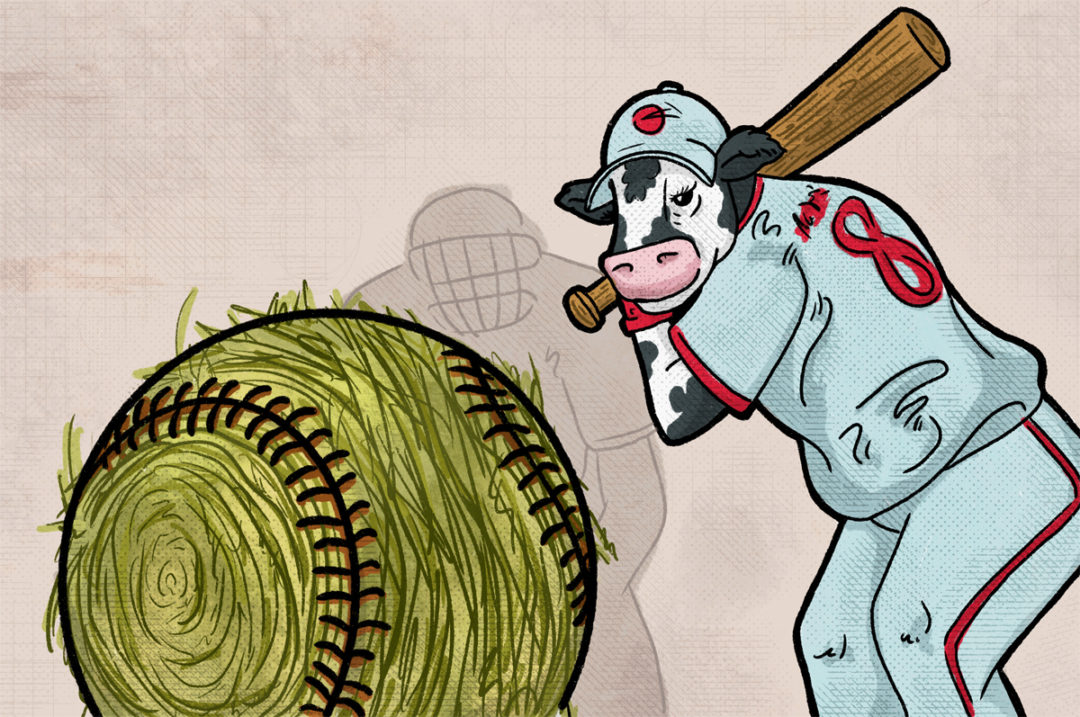To read this article in French, click here.
Mother Nature should be a baseball pitcher. With her set of curveballs, change-ups and fastballs, no batter would know what was coming until it was too late.
Each unexpected weather event, drought, heat wave, cold snap or any other knee-buckling pitch has an impact on your crop. Yields, nutritive value and feed hygiene can all be impacted, making the product you get out of the field unique from past years.
See the ball
You’ve put a tremendous amount of work into your silage crop this year, doing everything in your power to make sure you hit that sweet spot where silage yield and quality intersect. Unfortunately, Mother Nature’s curveballs may have challenged you with variability you just couldn’t control. When you’re feeding cows – the ultimate creatures of consistency – identifying and understanding the variability you’ve been dealt, and then doing what you can to manage for it, is key to keeping cows healthy and performing consistently at a high level.
This year, drought has had the biggest impact on silage yield and quality, covering a large part of the nation’s growing area. The impact of drought on a corn crop depends on the timing of the dry weather and how it relates to ear development. Drought stress that occurs during the silking and tasseling stage can be detrimental to kernel pollination and grain fill. Less grain could mean less starch and total dry matter harvested per acre. Drought occurring outside of this time frame may have a greater impact on the growth and development of the forage portion of the corn plant. In drought-affected areas, I would recommend you keep a close eye on starch and fiber digestibility. Last year, drought was similarly pervasive across much of the U.S., and starch digestibility was noticeably lower than in years past.
Drought can also increase the risk of mycotoxin contamination in your silages. Drought-stressed plants lack the ability to fight off various field molds, many of which can produce these harmful compounds. I’ve already come across numerous herds battling mycotoxins in their 2022 corn silage crop.
In talking with producers and nutritionists around the country, drought seems to have affected everyone’s crop differently. Some areas are seeing lower-than-expected starch concentrations and total yields. Others are dealing with feed hygiene challenges. Not only does the corn silage crop look different state-to-state, but you might have also experienced a great deal of field-to-field variability in silage quality and hygiene. Keep in mind that field-to-field variation can lead to dramatic shifts in corn silage quality as you work your way through the pile or bunker.
Hit the ball
With all this in mind, it’s important to take the necessary steps to make sure potential variability in your 2022 silage crop doesn’t derail your herd. Before we talk about steps you can take, we’ll assume your silages were harvested, inoculated, packed and stored properly to allow for optimal fermentation and inhibition of spoilage organisms.
The first and most obvious step is to make sure you’re routinely testing your forages for dry matter concentration, nutrient concentrations and digestibilities, and pathogen counts. Testing at harvest offers an opportunity to understand the quality and digestibility of the silage going into the bunker and to make any long-term feeding plans. Remember, fiber digestibility at feedout will look very similar to that at harvest. Starch digestibility, on the other hand, will improve as storage length increases. It is then very important that you routinely test silages as they are being fed to provide the most accurate estimate of actual nutritive value at that point in time. Dry matter should be tested multiple times per week, if possible. Work with your nutritionist to determine the optimal sampling frequency for analysis of nutrient concentrations and digestibilities of your silages, as well as important parameters related to feed hygiene.
Even if forage quality changes throughout the year, you can create a herd that is resilient to that variability by supporting the rumen and lower gut. In the rumen, supporting populations of beneficial bacteria, especially those responsible for digesting fiber, while inhibiting populations of detrimental organisms is key to optimizing rumen function and efficiency. In the lower gut, controlling pathogens, binding toxins and preventing intestinal permeability is essential.
In recent years, we’ve learned more about bacillus products and their ability to support a dairy cow’s rumen and hindgut. Recent studies conducted by our company have shown that its bacillus technology is uniquely capable of improving the resilience of dairy herds by controlling pathogens in the rumen and hindgut, supporting populations of ruminal fiber-digesting bacteria and reducing intestinal permeability. In these studies, supporting gut health and improving animal resilience was shown to directly influence herd performance, with increased milk production and feed efficiency observed in all trials.
Refined functional carbohydrates (RFCs), which are enzymatically hydrolyzed from the yeast cell wall, are another valuable technology for protecting a dairy cow from variable forage quality and hygiene. High-quality RFCs are highly bioavailable and help support digestion in the rumen while simultaneously protecting the hindgut from pathogens and mycotoxins.
When it comes to controlling pathogens, we have to remember that preventing contamination of clean feed should be step number one. There are numerous strategies for preventing feed contamination that can be implemented immediately with little to no financial cost. Routine cleaning of tractor buckets and tires and making sure feed pads are free from debris and spoiled feed are two examples of such strategies.
When Mother Nature throws us curveballs, some aspects of silage production and management are within our control. Unfortunately, there are many others outside of our control. Despite our best efforts, forage quality challenges and unforeseen variability can creep in and impact animal health and performance. When that happens, it’s vital to support the cow’s rumen and hindgut to minimize the impacts of this variability on the productivity and profitability of your dairy.










